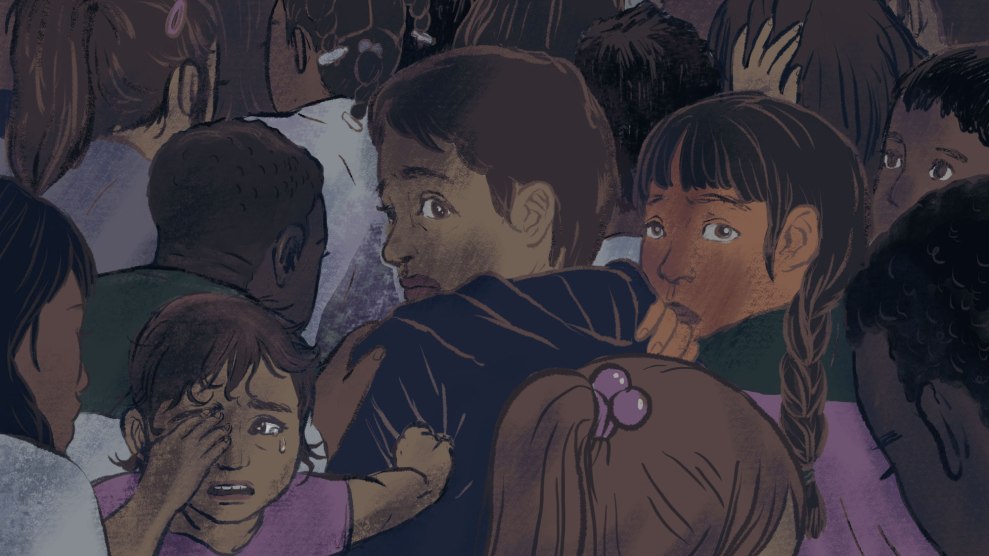
Acadia Healthcare cited out-of-state institutional placements of youths as part of its strategy to “increase volume.”Igor Golovniov/ZUMA
This investigation was originally published by ProPublica Illinois and the Chicago Tribune. ProPublica Illinois is a nonprofit newsroom that investigates abuses of power. Sign up to get weekly updates about our work. The Chicago Tribune is a daily newspaper that has stood up for its community since 1847. Please subscribe.
Across the country, child welfare officials have sent thousands of foster children to mental health institutions in distant states, including facilities where children reported being beaten and sexually assaulted by other residents or mistreated by workers.
The journeys of these children resemble an airline flight map: California to Virginia, Florida to Utah, Hawaii to Arkansas. Illinois officials have transported children as young as 7 to facilities in more than a dozen states.
One Chicago girl who was placed at institutions in Arkansas, Michigan, Ohio and Tennessee said she was sedated, subjected to bruising restraints and sexually assaulted by a facility employee, according to government records and interviews.
“I basically felt like I was abandoned, like nobody wants to deal with me,” said the girl, who is now 17.
Illinois officials also sent a 16-year-old boy to a facility in Indiana where police have been called to investigate dozens of battery allegations, including attacks that left children with broken bones or in need of hospital care.
“When I first got there, I got jumped every day by kids and staff,” said the boy, now 18.
Oregon officials placed a 9-year-old girl in an institution in Montana and didn’t visit her again for nearly six months, when they found her unwashed in an oversized hospital shirt, interviews and records show.
“It’s not right they send us so far from home,” the girl, now 10, said in a telephone interview.
Officials in Illinois and other states acknowledge they sent wards out of state to private facilities despite having a limited capacity to monitor the children’s care and safety. A Chicago Tribune-ProPublica Illinois investigation found repeated breakdowns in oversight as states—those sending the children as well as those receiving them — failed to protect young people in need of specialized care.
To uncover how these facilities treated children, reporters obtained and examined thousands of pages of police reports and interviewed foster children and their families. The investigation found that even when police and facility employees documented allegations of harm, officials responsible for the children did not always see or act on those reports.
Foster children from nearly every state in the country have cycled through out-of-state institutions in recent years, according to data from the federal Adoption and Foster Care Analysis and Reporting System, or AFCARS. Among them were children with serious medical and psychiatric diagnoses, records of juvenile delinquency and histories of running away.
Child welfare agencies sent 1,716 wards to out-of-state treatment facilities in 2018, the most recent year available, the AFCARS data shows. As of February, 55 Illinois children were in out-of-state facilities, according to the Illinois Department of Children and Family Services.
Placing children in out-of-state facilities should be a last resort, child welfare advocates say, because doing so can weaken family bonds and disrupt a child’s development.
“You’re removing them from their neighborhood, their community, and it makes it more challenging to have visits,” said Moira Weir, child welfare director for Hamilton County in Ohio.
Following years of reforms that had emphasized placing children closer to home, the number sent out-of-state began to climb nationwide in 2014 and peaked in 2016 at about 2,000, according to federal data.
The increase far outpaced the growth in the foster care population and, federal studies show, was partly driven by the opioid crisis, which sent more children into state care and strained resources.
Though the overall number of out-of-state placements has since declined, some states, including Illinois, have increased the practice.
The number of wards sent away from Illinois grew steadily from 19 in 2011 to 56 in 2018, according to federal data. Similar spikes were seen in Ohio and Oregon over the same period.
Like their counterparts across the country, Illinois officials have worked to limit the number of children living in institutions. But the state has failed to compensate for a loss of beds in residential facilities—Illinois has 472 fewer beds than it did in 2012—by developing sufficient alternatives.
In 2016, Illinois outlined in federal court documents a two-year goal of serving 140 children in therapeutic foster homes—placements that would offer round-the-clock services in a family-like setting.
Hampered by administrative churn, budget shortfalls and bipartisan political stalemates, DCFS has served just 80 children to date, according to records and interviews.
The latest person to oversee DCFS, Marc Smith, was appointed acting director last April. In an interview, he said he has made it a priority to bring foster children back to Illinois, improve monitoring procedures and increase the number of residential beds and therapeutic foster homes.
Smith said 38 residential beds have been added since he took over DCFS.
The only children who should be placed out of state, Smith said, are those with highly specialized needs who cannot be served in Illinois.
“We are committed to bringing every child in who’s out of state that can be safely and appropriately cared for in the state of Illinois,” Smith said. “For any child who can be cared for here, it is absolutely our goal to bring them back.”
“I Felt So Worthless”
The girl from Chicago, who has bipolar disorder, was taken from her mother’s care at the age of 11, moved through several Illinois placements and spent time in a facility in Arkansas. Then, in fall 2017, when she was 15, she was sent to a new home: the Detroit Behavioral Institute/Capstone Academy.
The previous year, Michigan officials had placed Detroit Capstone’s license on provisional status. The Michigan Department of Health and Human Services documented staff shortages as well as allegations of sexual assaults by patients and physical mistreatment by staff members.
At Detroit Capstone, one boy from Illinois got into fights almost every day, according to a department report, and suffered a black eye, cuts and bruises.
Illinois placed at least seven children at Detroit Capstone in 2017 and 2018, including the girl from Chicago.
In an interview, the girl said Detroit Capstone employees kept order by encouraging her and others to threaten and attack children who misbehaved. They were rewarded with snacks and privileges, she said.
“They got the kids to do their dirty work,” she said. “I admit it, I was one of those who did stuff for Snickers.”
She also said workers restrained children by “bending arms, choking and punching” them.
Her second month there, the girl said, a worker pulled her into a bathroom, blocked her from escaping and penetrated her digitally.
A state report on the December 2017 incident said the worker told the girl he would get her extra food if she didn’t tell anybody. Michigan child welfare officials and local police investigated, but Illinois DCFS officials said they did not know about the incident.
Detroit police closed the case without filing charges, citing the girl’s “illness” and “inconsistencies in her statements.” In all, police were called for seven reports of rape or sexual abuse and five reports of assault and battery at Detroit Capstone in 2017 and 2018, records show.
DCFS procedures require that facilities send any internal report of serious harm to the child’s Illinois caseworker, who then should enter it into a state database that enables officials to track patterns of mistreatment. But sometimes facilities didn’t notify the caseworkers, or caseworkers didn’t add reports they did get to the database, said DCFS spokesman Jassen Strokosch.
“The hard reality,” Strokosch said, “is that there is a drop-off at two points.”
DCFS officials said the agency typically checked to see if the license of an out-of-state facility was in good standing before placing children there but acknowledged they had no reliable system to check for subsequent sanctions.
Illinois has sent children to Resource Residential Treatment Facility in Indianapolis even though Indiana officials have halted placement of their own state wards there three times since 2017, citing violence and inadequate staffing at the facility.
In one instance, according to a state report, when Resource ran out of food and a child complained, a worker “picked him up by his broken arm (and) slammed him to the floor.”
A 2017 Indiana licensing report said Resource called local police “as a means of behavior management.” Indiana officials have also cited Resource more than 10 times since 2016 for not having enough employees to meet required staffing ratios.
During this period, DCFS had specific monitoring requirements for out-of-state facilities. If a child was placed out of state, his or her caseworker was supposed to walk through the facility at least every six months; monitors had to visit at least every quarter.
But a 2019 state report found that more than 20 percent of the mandated caseworker visits were not made.
Both Detroit Capstone and Resource are run by Acadia Healthcare, one of a small number of for-profit chains that operate the nation’s largest mental health facilities for children. Acadia declined to comment on specific facilities or allegations. But the company said it delivers superior outcomes for patients, “changing lives every day and in many cases saving lives every day.”
Acadia also said none of its facilities had ever “failed to be accredited, re-accredited, lost a state hospital license, or been suspended or de-certified” by any government health program.
“We strongly object to any allegation that our facilities are understaffed,” the company’s statement said.
DCFS said it discharged its last child from Resource in December and currently has no children at Detroit Capstone. DCFS’ Smith said the agency recently revamped its procedures and more than doubled the frequency of required visits by monitors and caseworkers. Every child placed out of state has been seen during the last three months, Illinois officials said.
“Things will be less likely to slip through the cracks because that relationship will be maintained,” Smith said.
DCFS transferred the teenage girl from Chicago out of Detroit Capstone in 2018 after the facility sought to discharge her because she was emotionally unstable, harming herself and “struggled with medication compliance.”
But instead of returning her to Illinois, DCFS transferred her to facilities in Ohio and Tennessee.
“I felt so worthless,” said the girl, who has bounced between living arrangements since returning to the Chicago area. “I felt like I was never going to make it out. I thought I would never get to freedom, that I would be locked up forever like an animal.”
A Hub For Children, Complaints
Surrounded by pine trees about an hour’s drive from Little Rock in southern Arkansas, Millcreek Behavioral Health is a complex of buildings holding more than 100 beds for children and teens with emotional and behavioral problems.
The facility has emerged as a hub for children from Illinois and at least 12 other states, but parents and mental health advocates say children have been mistreated there.
“We have serious concerns related to Millcreek—the treatment of youth and the educational programs,” said Tom Masseau, executive director of Disability Rights Arkansas, a nonprofit group authorized by Congress to interview patients and examine records at institutions throughout the state.
Masseau said his organization has documented patient injuries, lapses in treatment and inadequate education at Millcreek, which is located in the town of Fordyce.
Little information about Millcreek is publicly available from Arkansas officials. Unlike states such as California and Michigan, which post detailed facility inspection reports online, the Arkansas Department of Human Services provides only brief summary information about its inspections of Millcreek or other facilities in that state.
But Fordyce police call logs from January 2015 through February 2019 list more than 40 reports of runaways from Millcreek, 21 staff-on-resident assault allegations and 10 reports that children assaulted other children, as well as allegations of sex abuse. Fordyce police declined to comment on any of these reports.
In October 2018, an 8-year-old girl from Maine told employees that she had been digitally penetrated by another resident, according to a lawsuit filed in federal court in Arkansas against the facility. But Millcreek did not begin an investigation until the alleged attacker bragged about it to other residents, according to the lawsuit, which is pending.
The girl’s mother learned of the alleged incident only after asking administrators why her daughter had been moved to a new room, according to the lawyer for the family. Millcreek has denied any allegations of wrongdoing in the lawsuit.
For the family of a teenage girl from Hawaii, Millcreek offered hope that she could receive mental health services that their state could not provide. The girl, who had been diagnosed with schizophrenia and bipolar disorder, left for Arkansas shortly before her 18th birthday in 2016.
But in October of that year, her mother became concerned when she couldn’t get in touch with her daughter or the daughter’s therapist at Millcreek. She called Fordyce police.
In the end, Victoria Feinberg and her husband, David Jerke, flew to Arkansas. When they saw their daughter, they felt she hadn’t received proper care. “She had been sick,” Feinberg said. “Her gums were swollen.”
The family did what they could—taking her to the eye doctor, to the dentist and for a haircut—and left with the hope that Millcreek might yet help their daughter, a sensitive girl who had played guitar and violin before beginning to struggle in early adolescence.
But when the teenager was flown back to Hawaii months later in June 2017, she was heavily sedated and weighed only 90 pounds, according to her mother.
“Her face was sunken. She didn’t know my name,” Feinberg said.
Feinberg’s daughter is now 21 and being treated in an institution in Hawaii.
“Millcreek damaged my daughter horrifically,” Feinberg added. “They broke my daughter’s spirit. She thought she did something wrong and it was the punishment.”
Millcreek also is run by Acadia Healthcare, which operates more than 500 mental health centers for children and adults in the U.S. and the United Kingdom. In a 2016 company report, Acadia cited out-of-state institutional placements of youths as part of its strategy to “increase volume” of patients and maximize the number of government agencies paying for services.
Acadia officials declined to discuss allegations about Millcreek and said it could not comment on any patient. In a statement, Acadia said its treatment facilities “meet or surpass (in some cases by large margins) national averages in the majority of measured categories, including those related to patient safety.”
Acadia also cautioned against drawing conclusions from “anecdotal, non-representative incidents” and warned that “sensationalized” accounts could perpetuate “fear inducing stereotypes that could dissuade needy individuals from seeking life-saving behavioral health care.”
Relying On A Neighbor State
Located just 35 miles from Chicago in Schererville, Indiana, Campagna Academy became one of Illinois’ most frequently used and closely monitored out-of-state facilities.
When Illinois officials reached out to Campagna a few years ago, “we felt an obligation to fulfill our mission and help our neighbor state,” Campagna CEO Elena Dwyre said. “They were in need.”
Campagna’s spectrum of services includes an intellectual and developmental disabilities program, secured units and therapeutic day treatment. But records and interviews show that DCFS was sending children the facility wasn’t equipped to manage, and some youths there were mistreated by employees and involved in violence.
From 2016 through 2018, Schererville police responded to more than 30 calls involving reports of battery of a youth at Campagna, which serves nearly 300 children a year. Police also investigated six reports of a child sexually assaulting another child and two additional reports alleging that workers were pursuing children sexually.
More than 10 Campagna workers have been fired since 2016. One was accused of taking children out of the view of video cameras to hit them, another of pushing a child against a wall and yet another of sleeping on the job, according to court and police records.
One fired employee was charged with battery for allegedly whipping a child with a belt buckle and punching him after asking a co-worker if they were out of camera range. The employee was ordered to complete a six-month court diversion program.
DCFS said that for years it has monitored Campagna as closely as it monitors institutions in Illinois, making unannounced visits at least once a week and attending frequent staff meetings to ensure children are safe.
In response to allegations of abuse and poor oversight, Illinois in March 2017 imposed a corrective action plan on Campagna. Facility officials agreed to hire enough staff to provide “adequate supervision,” records show.
Two months later, Indiana child welfare officials stopped sending children to Campagna, as did Illinois. The halt allowed Campagna to retrain staff on safety, strengthen accountability and improve communication with its young patients. Both states resumed sending children to Campagna later that year.
Illinois placed the 16-year-old boy there in March 2018. He had become a ward of the state after his grandmother would not pick him up from a psychiatric hospital.
The grandmother, Emma Lee, who lives in the Chicago suburbs, said it was her only way to force the state to provide the boy with mental health services and support she couldn’t give him on her own.
His nearly yearlong stay at Campagna was marked by aggressive behavior toward others, self-harm and numerous hospitalizations, records show. In an interview, he said he was attacked several times during his first few weeks and became violent himself to survive, fighting with staff and peers.
At one point, he was confined to a cottage alone, accompanied only by the workers who supervised him.
Dwyre declined to comment on the specifics of any youth’s case but said Illinois sent children who needed a higher level of care than Campagna could provide.
In late 2018, Campagna officials canceled the Illinois contract. They now focus on treating Indiana children, Dwyre said.
DCFS said the three Illinois children who remain at Campagna have specific needs that Campagna specializes in treating and that DCFS has stepped up its monitoring of those children, who will be discharged when it is in their best interest.
“Our work with that facility right now is intensive,” DCFS’ Smith said. “We’ve worked closely with them to make sure our kids are cared for and are safe.”
Dwyre said Campagna is committed to transparency and reports every allegation of harm to police and child welfare officials. “Safety is always our priority,” she said, adding that since 2015 the facility has tripled its full-time nursing staff to 18.
The teenage boy is no longer out of state but has not found stability. Since being discharged in February 2019, he has run away from his placements in Illinois, stopped taking his medication and has been picked up by police, his grandmother said.
“He needed help. He didn’t get it. Now he’s worse,” she said. “There should be places in Illinois for kids like him.”
A Young Girl, Far Away
After dozens of Oregon children were sent out of state and local media published reports of mistreatment, officials in that state overhauled their policy.
At the center of their debates was a 9-year-old girl sent 750 miles from home to Montana.
Oregon took custody of the girl in 2016 after her mother was overwhelmed by the girl’s impulsive and sometimes erratic behavior. Two years later, the Oregon girl was flown to a facility in Montana run by Acadia Healthcare.
At the time, Oregon officials were under pressure to reduce their use of hotels and state offices as temporary shelters and had turned to facilities operated out of state.
Federal data shows Oregon sent 75 children out of state in 2018. By comparison, only one child was placed out of state in 2014.
During the court hearing when officials decided where to place the 9-year-old girl, Oregon authorities provided “very little information” about the facility they had chosen, said her lawyer, Annette Smith.
“It was like: ‘We found a placement. It is in Montana.’ There was no information presented about the facility’s history…of any downsides or risks,” Smith said.
Over the next months, the girl said in a recent interview, she was repeatedly physically restrained by staff, locked alone in seclusion rooms and sedated.
Smith sought incident reports from Oregon officials but said what she received was often contradictory and incomplete.
State officials were saying publicly that a caseworker saw the children they sent out of state every 30 days. But the girl went nearly six months without a visit.
Last April, an Oregon caseworker finally arrived at the Montana facility with an investigator from a nonprofit social services organization. According to the investigator’s report, they found the girl’s hair had not been combed, and she was wearing a dirty, oversized medical scrub shirt and hospital booties made of paper on her feet.
The girl’s mother, Adrian Spezza, also visited around the same time. Spezza said she asked for a bucket of soapy water and washed her daughter’s feet and cut her nails.
“She had been severely neglected,” Spezza said in an interview. “Really bad foot odor…it was nauseating. Her toenails were…overgrown to the point where it was pretty shocking.”
Shortly after the allegations of mistreatment surfaced, Acadia closed the facility and two others — decisions the company said were made for “overall business and operational considerations” and not because of alleged harm.
Acadia declined to discuss specifics about the Montana facility but said the company “dedicates millions of dollars each year to clinical quality, compliance and patient safety.”
Oregon officials also sent children to institutions operated by Sequel Youth and Family Services, which runs 40 programs in 20 states. More than 20 children from Oregon were being treated at a Sequel facility in Utah when a riot erupted in 2019, leaving teens injured and prompting a response from the local SWAT team.
Sequel Chief Executive Chris Roussos, who took over leadership of the company in April, said in an interview that Sequel has added clinical and ethics leaders to its management team, installed hundreds of cameras at its facilities and is training workers in crisis-management intervention. The site of the riot, Red Rock Canyon School, was closed last year.
“When children are in our care, that is an extraordinary responsibility,” Roussos said. “We’ve got to get that right.”
Last April, Oregon lawmakers started holding legislative hearings focusing on the plight of children sent out of state.
Oregon State Sen. Sara Gelser, a Democrat, grilled top child welfare officials and demanded to know why the number of children being sent away had skyrocketed and why the 9-year-old girl was not checked on by a caseworker.
“Something here has gone very, very wrong,” Gelser said at the time.
Not long after, Oregon officials arranged for the girl’s return.
In recent months, Oregon has worked to bring many more children back. As of January, 17 children remained out of state, down from a peak of 88 in March 2019.
The girl, now 10, is in a foster home after spending time at an Oregon treatment facility.
“This isn’t a kid that so desperately needed to be injected with drugs to be safe with herself and others, because she hasn’t been injected here,” said her attorney, Smith.
“She is now benefiting from better treatment.”
A New Model
Into a suburban Chicago home already bustling with her own five children, veteran foster mom Marnie Jamison has welcomed more than 70 state wards.
“Perfecting your craft—that’s how I feel,” the Lisle homemaker said of her 23 years as a foster parent. “I have improved over the years. I’ve gotten better.”
Still, Jamison was apprehensive when she was recruited two years ago to join the state’s pilot program for “therapeutic foster homes.” These homes are expected to accept children with significant behavioral issues who might otherwise be placed in residential treatment centers, and possibly sent out of state.
“It sounded awful, honestly,” Jamison said. “You hear about, your house could be destroyed, the kids could come after you.”
Therapeutic foster homes are designed to enable troubled young people to find a new footing over six to nine months. The goal is to transfer them successfully to a traditional foster placement.
The primary model being tested in Illinois was developed in Oregon to serve youths convicted of juvenile offenses. The short-term, intensive stays rely on caseworkers, therapists and skills coaches to communicate frequently with the foster parents.
In the weeks of training that preceded the arrival of her first therapeutic foster child, Jamison learned a point system that rewarded positive behavior, and practices that ensured a predictable environment, close supervision and clear expectations. A team of experts would be on call 24/7, she learned.
“In regular foster care,” she said, “you just get the children.”
Early outcomes from the initiative are promising, according to Anne Larrea Barclay, a consultant to Lutheran Social Services of Illinois, one of the private agencies contracted to run the program.
Thirty-five of the 43 children discharged from therapeutic foster homes successfully stepped down to a more traditional foster home, Lutheran found. The families that took in these children also received extra training.
Meanwhile, two-thirds of the therapeutic foster parents — including Jamison — brought on a second child.
“The early successes are encouraging,” Barclay said. “To replicate it with fidelity, that takes time. It is a lot of work to implement an evidence-based model.”
Still, plans to expand beyond Aurora and Rockford have stalled. Lutheran officials said they can add 10 additional Chicago foster families, but two other social service agencies that helped launch the initiative have dropped out. A fourth agency, Children’s Home & Aid, remains on board.
“It has proven to be a significant challenge to find foster parents that are willing to take youth with such high needs,” said one evaluation written for DCFS.
DCFS’ Smith said the agency is working “aggressively” to revive Illinois’ therapeutic foster home program.
Jamison said she came to believe in the model, even after everything she had feared came to pass.
One night, the first child she took in—an 11-year-old girl who had been discharged from a shelter—punched a hole in a wall, reached for the kitchen knives and tried to kick one of Jamison’s biological children.
After the girl threatened suicide and police took her to a hospital, Jamison was in constant telephone contact with her coaches through the night. The next morning, she walked the girl home.
“She thought she was going to get her way by being negative. She was trying to test me,” Jamison said. “But by the time I brought her home, she felt I wasn’t going to give up on her, and she was safe.”
The girl blossomed over her 11 months, Jamison said, getting A’s on her report card.
Said Jamison: “I feel like we are part of something new, something innovative, something that is making history.”
Lauren Dake of Oregon Public Broadcasting contributed reporting from that state.
Northwestern University Medill School of Journalism students Ashley Hackett and Becky Dernbach contributed as research assistants along with seven other Medill students: Aqilah Allaudeen, Miriam Annenberg, Natalie Breymeyer, Mary Hall, AnnMarie Hilton, Nora Mabie and Daniel Jose Viegas.












